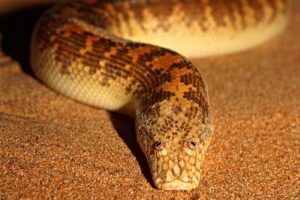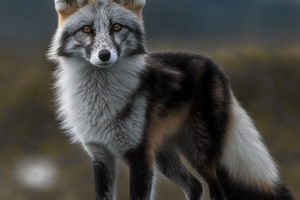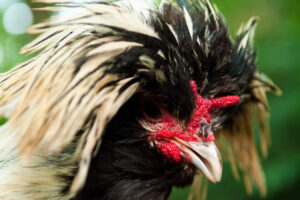In 1996, a small, striped animal, the size of a turkey, was discovered on the rocky seabed in China. It was a predatory lizard covered in soft feathers, with a predatory mask, like a raccoon.
This dinosaur had spent 125 million years at the bottom of the sea, and scientists around the world welcomed it. This animal is now called a down lizard ( sinosauropteryx ), but it is the first feathered dinosaur that has been found, albeit without wings.
The downy lizard disproves the old theory that feathers were created so that birds could fly. The feathered ancestors of the roughly 10,000 species of birds that now exist seem to have had no ambition to take flight from the surface of the earth, as paleontologists and ornithologists imagined.
We remain open to the possibility that feathers may have played an important role in the collective history of dinosaurs.
Paul Barrett, p rofessor and expert on dinosaur evolution
What was the purpose of the feathers then? Two feathered lizards have been found, and as a result, the debate about the first feather came to a head again, and they have clashed with the family tree of the dinosaurs, all the way down to the tree roots.
Predatory lizards were feathered
The first fossilized feathers ever found were discovered in 1861 between two limestone slabs near the city of Solnhofen in southern Germany. The feather was 150 million years old and had probably belonged to the lizard bird ( archaeopteryx ), whose fossil was found nearby.
For almost a century, all research into the origin of feathers was based on this one fossilized feather, as well as the lizard. This led to the fact that feathers and flight were linked together as inseparable wholes.
There, however, scientists were at a loss.
After the downy lizard ( sinosauropteryx ) was found at the bottom of an old lake in China, it is quite clear that the feather has played a role other than helping the animal to overcome gravity.
Sinosauropteryx did not have flight feathers, but this lizard was covered with feathered fur, which in English is called “dino fuzz”, but it consists of so-called primitive feathers, i.e. delicate, primitive feathers that resembled hair. The function of the primitive feathers has probably been to provide the animal with insulation against the cold and thus to help it keep warm.
Dinosaurs used feathers to keep warm
Until 1999, scientists believed that feathers were rooted in scales, but ornithologist Richard Prum of the University of Kansas managed to correct that misconception. Feathers, on the other hand, are rooted in a small groove in the skin and grow in steps, which also reflects the development of feathers in evolutionary history.
Soft branches of the primary down are formed
The primary feather continues to develop into the so-called primary down, with a short shaft and long, soft branches. Some dinosaurs, including snared dinosaurs, were covered with such primitive down all over their bodies, which probably served as insulation.
The shape of feathers lifts birds
The last step in the development of the feather is the curling branches, otherwise known as flags that hook into each other and form a compact structure. The flight feathers of today’s birds are asymmetric, which means that the air is brought up more quickly over the wing than under it, which contributes to lift.
When scientists in various fields agreed that birds had their roots in dinosaurs, serious research on the origin of feathers began.
Various significant fossils have been found in the past two decades, including prehistoric birds and at least five different species of predatory lizards with varied feathers and scales that resembled feathers.
These discoveries cannot be attributed in the least to the improved political situation across the world, including open borders to China and fossilized treasures in that country; young and energetic paleontologists, as well as new technologies such as LSF radiation, where a laser beam can illuminate soft materials, such as fur and feathers, that would otherwise be invisible.
These discoveries have made a difference, because feathers not only tell about the kinship of the animals and therefore shed light on their evolutionary history, but they also provide knowledge about the physiology, way of life and behavior of the animals.
Hairy plumage, like that of Sinosauropteryx , may for example have made it possible for the animal to maintain a constant body temperature, as is the case with birds and mammals.
Analysis of the melanocyte pigment in the feathers has further revealed that Sinosauropteryx was red in color with light stripes on the tail. The color combination is in good agreement with the fact that the animal lived in an unprotected environment, because the dark spine and white belly formed a pattern reminiscent of silhouettes.
The animals that live in the open country have a clear color difference between dark and light color on the upper abdomen, while animals that live in the forest have an indistinct color difference lower on the body.
The color difference at the top of the abdomen erases some of the shadows created when the sun shines on the body, with the result that the animals appear to be “flat”. As a result, predators have a harder time spotting Sinosauropteryx in the landscape.
The fourth predatory lizard belonged to the same branch of predatory lizards, the coelurosauria , to which branch belong both the grass lizard ( T. rex ) and the small graceful carnivores that have been called snap lizards that we know from the movies about Júragarden.
As a result, everything seems to indicate that feathers evolved into a subspecies of predatory lizards, and when scientists finally thought they had figured out the origin of feathers, a small horned creature appeared and overturned all their theories.
Herbivores spread their spines
A fossil of the herbivorous psittacosaurus revealed spikes protruding from its tail. The spikes were hollow inside and most reminiscent of primitive feathers.
Psittacosaurus belongs to the class of horned dinosaurs, but to that class also belongs the rhinoceros ( triceratops ) and is a long way from these animals on the one hand and predatory dinosaurs on the other hand on the family tree of the dinosaurs.
In 2014, another herbivore was found that was also equipped with a kind of skin growth, and it is the kulindadromeus that was found in Kulinda in the eastern part of Siberia. This lizard was the size of a medium-sized dog, extremely well preserved and wearing a special “overcoat”.
This coat consisted of three types of scales, a coat of quick hairs, as well as bundles of fiber combinations that most resembled small, coiled laces.
Furthermore, kulindromeus had single hair-like spikes on its head, neck, and torso, while its forelimbs and thighs were covered in small tufts of five to seven feather-like spikes. The last one attracted considerable attention, because similar hairs had previously been seen on predatory lizards, as well as on modern birds.
The meeting place is estimated to be approx. 168 million years old and as a result kulindromeus is considered to be the oldest dinosaur ever found with what looks like feathers.
Various scientists considered this discovery to be a sign that the common ancestor of all dinosaurs had been feathered, because they thought it unlikely that such a perfect feathering mode, as seen in the carnivorous sinosauropteryx and the herbivorous kulindromeus, had developed in isolation in these two main branches of dinosaurs.
This hypothesis does not stand up to reason, especially because feathers are rarely found among herbivores from the group of dinosaurs. Some researchers are more inclined to think that feathers formed several times randomly on different branches of the family tree.
Lizards had four types of feathers
In their search for a common ancestor, the researchers looked at the pterosaurs, a pterosaur that lived at the same time as the dinosaurs 230 to 66 million years ago. Interestingly, lizards belong to a completely separate branch of the family tree that has its roots tracing a direct path back to a common ancestor.
A team of scientists from various countries, led by paleontologist Mike Benton, studied two 160-million-year-old fossilized lizards from China and found patterns believed to originate from four different types of feathers on the head, neck, body and wings.
“The patterns are the same as those seen in the feathers of birds and dinosaurs, which means that we can date the origin of feathers from being 160 million years old back to 240 million years ago”.
Paleontologist Mike Benton.
The timing is consistent with the extinction at the end of the Permian period 252 million years ago, which was the third and most severe mass extinction in Earth’s history, when about 95 percent of all animals and plants were killed by massive volcanic eruptions.
When life started again after this, it happened in a different way than before. The first dinosaurs and mammals evolved, lizards turned into sea animals, and then got wings and began to fly.
Scientists behind the study are of the opinion that the common ancestor of dinosaurs and lizards developed primitive feathers as insulation 240 million years ago, but that other functions of feathers developed much later.
They base their opinion on genetic studies that demonstrate the common origin of scales, hair and feathers across species.
This means that all types of dinosaurs had the opportunity to develop feathers, but that environmental factors and mutations determined whether and in what way the genetic markers behaved. Some of the animals never grew feathers, while others were feathered for a time and then lost their feathers.
“Feathers” were petrified fibers in decay
However, this interpretation has not gained favor among scientists other than Mike Benton and his colleagues, because both paleontologists and supercomputers strongly disagree with the results of the scientific team.
Dr. David Unwin, of the University of Leicester, is an expert in the field of lizards and completely rejects the fact that the wings of the lizards were covered with any kind of feathers.
He notes that only 30 lizards have been found, some of which have well-preserved wings, but that they are all bare and smooth. On the other hand, the wing membrane contains morphologies that are easily misread when in a decomposed state, as they can appear down-like when viewed under a microscope.
We know there are fibers in wings. As they break down, they change and disappear, so they look like fluffy branches.
David Unwin, lizard expert
The lack of knowledge of the decomposition process poses a significant problem, according to David Unwin, because it makes it difficult for paleontologists to identify morphologies in fossils that have both compressed and heated over millions of years, deep in the earth.
Paul Barrett, a professor and expert in dinosaur evolution at the Natural History Museum in London, has come to the fore with a new book on the ‘origin of feathers’.
Barrett, along with two other scientists, has been working with probabilities and computer models, and with that method he has tried to calculate backwards to the first feather .
The scientists fed the computer models with a dataset that included 77 dinosaur species, all of which had been found with some form of preserved skin with traces of scales, hair or what looked like feathers.
The dinosaurs were found a place on a family tree, and in the places of the tree where no fossils had been found, the scientists inserted imaginary fossils. On one model, they inserted a butterfly with a primitive feather, and on another, a non-feathered butterfly was placed.
In this way, they were able to recreate different trends and to calculate the probability that individual lines corresponded to reality.
The models revealed that the common ancestor of dinosaurs and lizards was unlikely to have been equipped with feathers.
“I had made up my mind that if we developed a model based on a lizard with protofeathers, it would lead to all dinosaurs being feathered.” I was really surprised that it wasn’t the case,” says Paul Barrett.
The feathered puzzle is missing
The results of the computer models reveal that despite all that has been discovered in recent years, important information is still missing. And although the study rejects the existence of a feathered common ancestor, Paul Barrett believes the picture could easily change.
“We are still open to the possibility that feathers may have played a crucial role in the collective history of dinosaurs.” If we only found one or two of the first dinosaurs, their miserable relatives that were equipped with feathers, then our assumptions would change significantly”, he says.
Three things that have been discovered changed the appearance of the dinosaurs
Previous ideas about smooth and scaly dinosaurs, like those shown in the films about Júragardinn, are on the decline. Now the dominant ideas are that the lizards had a feather mode.
The tyrannosaurus rex was a down-covered killer
Scientists previously believed that large dinosaurs did not have feathers, as large animals have an easier time keeping warm than smaller ones, but in 2012, however, a nine-meter-long forerunner of the graminosaur, the Yutyrannus , which lived on Earth 125 million years ago, was found in China. or thereabouts. This giant predatory lizard had primitive, downy feathers, and although no feather formations have been found on the gram lizard, there are many indications that it had feathers of some kind.
The lizard’s hind limbs were covered in feathers
Although feathers cannot form from scales, the opposite is possible. Small predatory lizards are often depicted with scaly feet, but chickens, the dinosaur’s closest living relatives, have two types of scales on their feet: small circular reptilian scales, and coarser scales that have evolved from feathers. Fossils from Liaoning, China indicate that among other lizards had feathered toes.
Rhinoceroses had short, stiff spikes
Paleontologists have long been convinced that the large, horned rhinoceros was hairless and featherless, but since it is related to the much smaller paedophila, which had long, stiff spikes on its tail, they are no longer so sure. A layer of the python’s skin indicates that it may have had similar spikes. However, scientists are by no means sure that the spikes are related to feathers in any way.
The ancestor of the dinosaurs first appeared in the Triassic period 251-200 million years ago, and according to paleontologist Bent Lindow at the Natural History Museum in Copenhagen, it would be classified as pure luck if such an old feather was found.
“It will be difficult to find such old fossils, because there must be completely unique conditions in place if soft tissue is to be preserved. However, it is not completely excluded that such a thing will be found, and we can start by conducting a targeted search”, he says.
The closest relatives of birds, dinosaurs and lizards are crocodiles, all of which belong to the suborder archaeopteryx. The first crocodiles appeared in the Triassic period, and although they are not feathered, the ability to develop feathers is present in the genome of modern crocodiles.
So it can be thought that somewhere in the rock is hidden a fossil distant, feathered relative of crocodiles, which is only waiting to be discovered, as was the case with the down lizard ( sinosauropteryx ) 25 years ago. Nothing is missing but one feather.





















